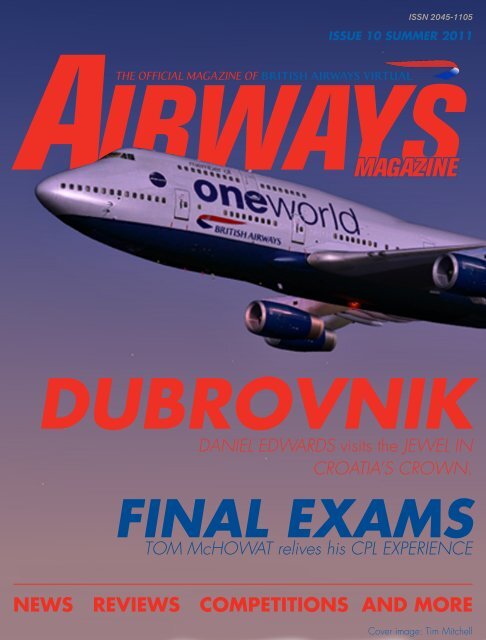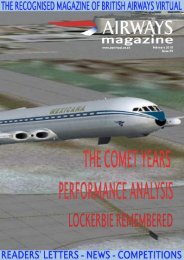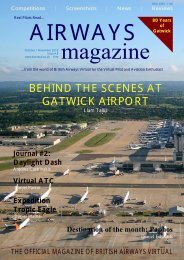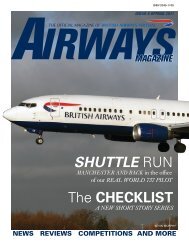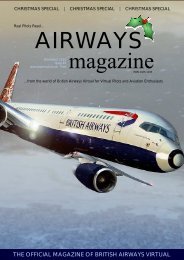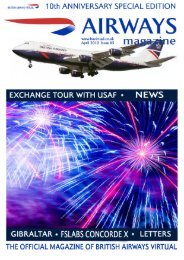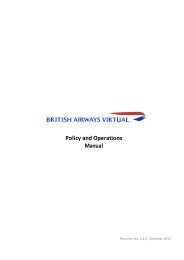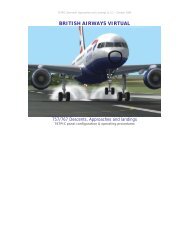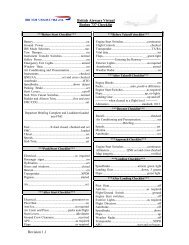FINAL eXAms - British Airways Virtual
FINAL eXAms - British Airways Virtual
FINAL eXAms - British Airways Virtual
- No tags were found...
Create successful ePaper yourself
Turn your PDF publications into a flip-book with our unique Google optimized e-Paper software.
issn 2045-1105Issue 10 summer 2011magazineDUBROVNIKDaniel edwards visits the jewel inCroatia’s crown.<strong>FINAL</strong> EXAMSTom McHowat relives his CPL ExperienceNews Reviews Competitions and moreCover image: Tim Mitchell
<strong>Airways</strong> magazineEditor in Chief &Creative DirectorJames PalmerFeatures EditorChristopher ElliottNews EditorChris SiegristImages EditorNeel PatelWebsiteMaintenance:Alan HunterEditorial ContactEmail:airway@bavirtual.co.ukWebsite:www.bavirtual.co.uk/about/pressBAV DirectorsCEO: Stephen EllisHR: Tom MoseleyOperations:Florian HarmsTechnical:Adam Parnell & AlanHunterTraining:John Barnes &Stephen BellConsultants:Rob Parker,Stephen Ellis &Graham YoungSubmissions<strong>Airways</strong> Magazine willhappily accept and reviewfor publication all letters,photographs, screenshots,articles, or other contributions.However, we do not guaranteepublication. <strong>Airways</strong> Magazineis unable to return anysubmissions sent to us and wewill not be responsible for theirloss. We will try and respondas soon as possible. Anythingsent to us will be assumedsuitable for publication unlesswe are notified otherwise.CopyrightThe entire contents of <strong>Airways</strong>Magazine is © 2010 - 2011 andno part of this magazine maybe reproduced in any form orstored on a retrieval systemwithout prior permission of thepublisher, BAV Publications.BAV Publications takesconsiderable care and attentionto ensure the accuracy ofthe information published in<strong>Airways</strong> Magazine; however,we cannot be held liable forany loss or damage resultingeither directly or indirectly fromany error or omission.We are pleased to recogniseall trademark and copyrightholders and try to wherepossible. If we make a mistakeor omission, let us know andwe will correct it in the nextissue of <strong>Airways</strong> Magazine.Legal<strong>Airways</strong> Magazine is producedfor <strong>British</strong> <strong>Airways</strong> <strong>Virtual</strong> andis completely independent.The thoughts, views andopinions expressed herein arenot necessarily the thoughts,views and opinions of <strong>Airways</strong>Magazine or <strong>British</strong> <strong>Airways</strong><strong>Virtual</strong>, it’s Directors, Managersor Pilots.<strong>Airways</strong> Magazine is producedfree of charge for the membersof <strong>British</strong> <strong>Airways</strong> <strong>Virtual</strong>, andall articles are freely submitted.The Editor of <strong>Airways</strong>Magazine reserves the rightto change articles for clarityprovided that it does not altertheir Meaning.<strong>Airways</strong> Magazine is no officialmedium of <strong>British</strong> <strong>Airways</strong>PLC and any or all logos usedherein are the property of theirrespective owners and usedunder strict permission.© All Rights Reserved.Any and all aviation advice,guidance, information, tipsand techniques containedherein are for the exclusiveuse of <strong>Virtual</strong> Pilots within theenvironment of Microsoft FlightSimulator and as such are notto be used or attempted in areal world aviation environmentunder any circumstances.
<strong>Airways</strong> magazinenewsGrimvötn eruptsOn the 21st of May,the Icelandic volcano‘’Grimsvötn’’ erupted.The volcanic ash climbedtowards the sky and beganto cover it. While expertsweren’t forecasting amassive disruption like‘’Eyjafjallajökull’’ resultedin. Still on the same day,flights all over Icelandwere cancelled. The ashcloud started to movesouthwards against Scotlandand Scandinavia overthe following days. As aresult, flights originating inScotland were cancelled.Mainly Domestic, Europeanand Intercontinental flightswere cancelled for the day,while Charters to Spainand Portugal were runningnormally. Airports in Scandinaviawere closed as well.The following day, theash cloud had movedtowards the northern partof Germany. As a result,airports in Berlin, Hamburgand Bremen were closedfor a few hours, until itbecame clear, that theamount of ash lying inthe air couldn’t affect anyaircraft.A few days later, mostflights were running normalagain.Finally, on the 28th ofMay, Grimsvötn’s eruptionstopped.If you’re bored,rent an iPad....Iceland Express, anExpress states following:as in-flight entertainment.Icelandic low cost carrier,has introduced an offer torent an iPad on all theirtransatlantic flights.‘’In case you don’t havesomething better to doon our flights, we’re nowoffering a shiny new gadgetfor your fondling pleasure.Fancy that.On it, you’ll be ableto watch movies andtelevision shows, listen tomusic, read magazines andPassengers, which wishto make use of this offer,pay £9 for one flight.On their Blog, IcelandIt’s called an “iPad.” (Youmay have heard of it.) Andapparently we’re the firstEuropean airline to offer itplay games. Also, waving itaround is a really good wayto get the immediate attentionof our cabin crew’’Malév’s new CEOOn the 1st of June 2011, Malév Ground Handling inOneworld member and 1993.Hungarian flag carrier He’s taken over theMalév appointed it’s new position, after Martin GaussCEO, Lóránt Limburger. stepped down in March2011.Limburger has been Beside his active role, hepreviously active as CEO of will continue looking afterMalév Ground Handling, Malév’s ground handlingsince 2007. He joined operations.New Naplesscenery onthe roadFSX BAV pilots flyingthe BA route fromGatwick to Naples willnow be delighted withNapulevole’s newestrelease.People using this betaversion of the scenery canenjoy a custom runway andtaxiway textures, aswellas custom buildings andtextures. All this with a verygood freeware quality. Thescenery can be found onthe developers website.
<strong>Airways</strong> magazinenewsBoeing recievesmore ordersfor the 747-8iMalaysia Airlinesto join oneworldThe national airline ofMalaysia, MalaysiaAirlines has beenelected to joinoneworld.The airline, which wonan award lately, is expectedto join the alliance in late2012. The membershipwill expand the range ofIt’s the 27th of September1964 as the BAC TSR.2,registered XR219, lifts offfrom Boscombe Down.The aircraft, which wasdesigned to be a tacticalbomber, as well as a reconnaisanceaircraft, nevermade it to the productiononeworld destinations toalmost 950 in 150 countries.The carrier alreadyhas codeshare agreementswith Cathay Pacific andRoyal Jordanian. Thecarrier commenced it’s firstcommercial flight in 1947as Malayan <strong>Airways</strong>Limited.line with only three prototypesbuilt (XR319,320 and322). Now Virtavia enablesFS9 pilots to fly the aircraftvirtually. Virtavia is quite anew developer, but they’vetaken over Alphasim’sproduction line.The aircraft comes withthree different models andAt the Paris Airshow,Boeing announced, thatthey’ve received 17 moreorders for their 747-8i.The orders, valued at$5.4 Billion, have beenplaced by two unidentifiedcustomers. The orderbrought up the total ordersto 50 airframes, alog withfive Air China ones, whichare subject to governmentalapproval. This has been thelargest order placed for the747-8i since Lufthansa’sorder for 20 airframes backin December 2006.BAC TSR.2 releasedhigh quality textures andsoundsets. The aircraftcontains a 2D cockpitand a virtual cockpit, bothequipped with a HUD. Toentertain the user, Virtaviahas added animations suchas: Jetpipe nozzles, brakechute, tail squat and manymore!Rolls-Royce Trent1000 receivesETOPS certificationThe Rolls-Royce Trent1000, which is plannedto power the Boeing 787Dreamliner, has receivedit’s ETOPS certificationfrom the FAA.The ETOPS certificateallows all Boeing 787’sequipped with Rolls-Royce Trent 1000’s tofly over parts of the worldwith an alternate airport upto 330 minutes away.The Trent 1000 haspowered the Dreamliner’sfirst flight in 2009and is installed on five ofthe seven aircraft involvedin the test program.AIRWAYS NEEDSYOU!NEWS, REVIEWS ANDFEATURES!BE PART OF THETEAM!emailairway@bavirtual.co.ukfor more information
<strong>Airways</strong> magazinethechecklistA Short Story byChristopher ElliottTurning off the intercom, Paul sat back and relaxed. He knewthey would more than likely have to stay over at the alternate andrealised he wouldn’t be seeing his family for a few days longer thananticipated. It would be fine. The time was 1513z.Captain Paul Berkeley had been a pilotsince his childhood. Whilst at school, hehad become a proficient glider pilot soaringin and around Goodwood aerodrome beforegaining his Private Pilot’s License andjoining an airline training scheme. He hadnever encountered a major problem in theair before; yet, he was highly trained and askilled airman. He always said he enjoyedthe view from his office window and, perhaps,this made him too comfortable. Nevertheless,he was regarded in high esteemby his colleagues.Hand flying the twin jet through thesun soaked blue toward St. John, Paul kepta careful eye on his airspeed, altitude, attitudeand last remaining engine. The gaugeswere all pointing to where they shouldbe and his descent profile was perfect. Paulwas wearing his standard issue uniform ofwhite shirt, gold epaulets; black tie andtrousers, appearing as the ever proud professional.He reached forward and pointedat the navigation display.The display was black with magentalines and a compass rose at the top. Therewas an arrow denoting wind direction witha reading for wind speed on the display andSt’ John’s airport was just showing at theedge of the outer range rings. First OfficerJohn Rigby looked over and said, “I see it,Paul. 183 nautical miles to go.”“Okay, “ Paul said, “Whilst I holdher steady here, John, would you go backand see what’s going on in the cabin? Wehaven’t heard from them and I’m concerned.”John said, “Are you sure that’s agood idea? There may be someone onboardholding hostages.”Paul smiled. “Don’t worry, John,” hesaid. “If there was someone on-board theywould have made it for the cockpit by nowor called us with their demands.”John pressed a button to electronicallymove his seat back. “Alright,” he said.“If I am not back in five minutes then assumethe worse.”“It’s just procedure with this airline.The internal comm’s may have beenknocked out too by whatever is happeningto this aircraft. Am sure it’s nothing. Besides,we can’t be that unlucky to have anengine problem and a hijacking.”John said, “You’re right, that wouldbe unlikely. See you in a minute,” arosefrom his seat and left the cockpit slammingthe security door shut behind him. Paulwas alone.On-board a twin-jet airliner, there are twomachines, called Packs, which provide airto the cabin to maintain pressurisation andsupply oxygen to the passengers and heating.They run from bleed air taken from theengines, whilst they are running. Earlierin the flight, Paul has turned off one of thePacks due to overheating. This meant thatonly one was running - this was now malfunctioningdue to the shut down engine.Throughout the cabin, the occupantshad been falling unconscious after a drunken-likebout of Hypoxia. As John enteredthe cabin, he would have quickly sufferedfrom the lack of oxygen in the cabin, whichwas creeping forward toward Paul in thecockpit, searching for the cockpit door andthe gaps around it to suck out the remainingoxygen. If Paul wouldn’t realise this, hewould be unconscious in minutes. Deathwas on the horizon.As Paul watched the instruments,he realised that 14 minutes had passedsince John had left the cockpit. Thinkingthis was strange; Paul reached and pressedthe Flight Attendant’s call button. But, ofcourse, no one answered it.The last air in the cockpit beganleaving and Paul started to feel a littledrunk. He began laughing and was becomingincreasingly unable to think. Theaircraft was rolling left to right more andpitching up and down as Paul struggled tocontrol the jet airliner full of passengers.The speed was decreasing and before longthe plane would be falling straight down ina stall. An alarm sounded and a messagedisplayed on the screen, CABIN PRESSURE.Paul, not knowing, just hit the alarm cancelbutton; but, the message was still displayedas he felt more and more drunk.In the oxygen starved cabin, somepeople had been starved of oxygen for longerand had been unconscious, unable tosave themselves. A few of the passengersand a crew member began to turn blue asthey passed where they had slumped. Therewas nothing anyone could do to save themnow. Paul needed to start the other Packand cross-feed the air from the running engineto the malfunctioning pack if anyonewas going to survive.To be continued...
<strong>Airways</strong> magazineKaroly Nagy
<strong>Airways</strong> magazine
<strong>Airways</strong> magazinefeatureCPL TESTOxford Aviation AcademyThe CPL Flight Test Experienceby Tom McHowatThe last five months of prettyintensive flight training allcame to a head in this two and ahalf hour flight. I woke up on themorning of my CPL flight test with thebutterflies and the hot flushes, as youwould expect. I’m not one to get nervousat any sort of written exams, which is whyI was fairly relaxed during the ATPL groundschool phase. But I knew that flight testswere a real weakness when it came to beingcalm – it was the same on my PPL flighttest in Australia, and it was the same onthe four progress tests that Oxford put youthrough in Arizona, all completed before theCPL. But, at least I’m not like my housematewho sat his test the previous week.The day before his he was curled up in thefoetal position on the sofa with his head inhis hands.As I ate breakfast (a banana, a coffee, acan of Red Bull and a cigarette) I added upthe pros and cons, as I had done over thelast few days. On the plus side, it’s onlytwo and a half hours of mental and physicalstress. The pass rate at Oxford is prettygood. On the negative side, it’s two and ahalf hours of mental and physical stress.I’m seriously nervous and should I fail Iwould have to pay for the privilege of resittingthe test. Obviously in that state ofmind, the negatives are at the forefront ofyour thoughts.I gave the weather a quick check beforeI went in for my 8:30 brief. Surface observationswere good; the TAF from LukeAir force Base and Phoenix indicated thatclouds, visibility and wind would be goodfor my flight up until about 2pm where thewind would start gusting to about 30 knots.We would be back by 12:30pm. Looks like Iwas set to go!After another smoke (I bought a packjust for the before and after of the occasion)I made my way upstairs for my briefingwith Paul Taylor, my examiner. He was niceenough, I’ve seen him milling around – he’sa grumpy old man at heart and he knowsit, which is why he can pull it off – actuallyquite nice. The briefing started withsome verbally discussed questions, rangingfrom our route for the day, the aircraft andother things. He asked me about suitablealtitudes, entry for circuits at our aerodrome,how the landing gear on the aircraftworked, why there were two static ports,what kind of ailerons the Seneca had andhow they prevented adverse yaw, what to“two and a halfhours of mental andphysical stress. I’mseriously nervousand should I fail Iwould have to payfor the privilege ofre-sitting the test”look for in the nose compartment duringthe pre-flight check. Also asked was whatwas needed in the aircraft for it to be airworthy,what the airworthiness directivesin the technical logbook meant, what the-200T in ‘PA34-200T’ meant (200bhp withturbocharger) and other technical questions.After the questions we discussedthe ones that I answered ambiguouslyand then he moved on to discuss exactlywhat was going to be done in the aircraft.I received my route from him the previousday and had planned it out. We would headfrom Goodyear to a disused aerodromeabout 40 miles to the West. About twominutes before our ETA to that aerodromehe would ask me to divert to somewhereelse. On the diversion he would simulatean engine fire. We would then move on togeneral handling, then circuits at an aerodromecalled Gila Bend (untowered) andthen back to Goodyear. On completion ofthe brief, I collected the aircraft documentsand went out to start the pre-flight.Adrenaline was too high at this pointto feel nervous. As I exited the building Iwas greeted with this disgusting heat thatyou get in Arizona. A wind in a hot situationis meant to be pleasant, cooling – butout there it’s like someone has lit a bonfireand is blowing the flames your way. Afterabout half an hour I was finished withthe pre-flight, and Paul was on his wayout towards our beautiful Piper Seneca,N2828L. I called a fuel truck and asked for50 gallons each side. Looking at the priceon the fuel truck as the numbers climbedanswered my question of, “Where doesall that money that we pay Oxford actuallygo?” Once the truck left, Paul and I hoppedin.Before start-up I gave Paul a full passengersafety brief. He’s heard it a milliontimes, but the purpose of the test is toensure that I can operate the aircraft asa single pilot in command. During startupand taxi out, the aircraft was behavingitself. Engines started without a problem,all of the power and pre-takeoff checkswent smoothly. My mate was telling methe other day how his Gyro Pressure warninglight was inoperative during his run upchecks and he didn’t know whether it wasa go or no go situation. Luckily none ofthis happened to me. After the pre-takeoffchecks I gave ground a call and asked fortaxi to the active.On arrival to holding point A1 for runway21 I gave tower a call asking for a straightout departure with a short delay on the runway,also with a simulated rejected take-
<strong>Airways</strong> magazinefeatureoff on the roll. All of this was granted, soI asked Paul to shut the door, I turned thetransponder to ALT and flicked on the landinglights. I lined her up on the runway andheld the toe brakes. Increased the manifoldpressure up to 2000RPM, checked temperaturesand pressures, feet off the brakesand manifold pressure up to 35 inches. I feltthe familiar ‘shove’ as those Ray-Jay turboskicked in, and we were off. I was expectingPaul to ask me to abort the takeoff, butI didn’t know when. We rotate at 77 knots,and at 70 knots Paul said, “Your rear doorhas come open.” I closed the throttles,announced ‘Stop stop stop”, and on Paul’srequest, continued the takeoff by addingthe power back in. Rotated smoothly at 77knots, gear up at 89 knots, and on with ournavigation route.I was lucky enough to have flown thatroute a couple of days before with myinstructor, so I knew what I was looking for.Visual check features included two powerplants and a pumping station. Everythingwent very smoothly, which is great for theconfidence. It’s important that if somethinggoes wrong in the beginning of the flight,you do not let it hurt your performancelater. I needed to be within 2 minutes of myETA at the disused aerodrome, and I couldadjust my ETA any time, except ridiculouslyclose to the destination. En route, I startedto think of places that he could ask me todivert to. Then I realised I was making thefundamental mistake – don’t think aboutwhat’s going to happen later in the test,concentrate on the now. If you have tonavigate, then navigate. When you divert,think about the diversion, not about the airwork or circuits that are coming up. Sureenough, with 2 minutes to go until my ETA,Paul said, “Once you get to the disusedaerodrome, divert to Hyder”. Now Hyder isa tiny town on a road which runs by quite alarge mountain. I’d not been there before,but knew what I was looking for. I knew Ihad two minutes to plan this diversion, sostarted immediately. Trying to write thingsdown, draw on your map and hold the planesteady in horrendous thermals is a challengein itself. This is what you have to beable to do in two minutes:• Figure out the true track to yourdiversion point• Figure out the true heading to yourdiversion point using the winds aloft• Apply magnetic variation to your trueheading to get magnetic heading• Figure out the distance to your diversionpoint• Figure out your groundspeed towardsyour diversion using the winds aloft• From the above, work out a time tothe diversion point, and therefore an ETA• Check appropriate altitude, fuelneeded to divert and visual check featuresI managed to complete that list withabout 30 seconds to go to the disusedaerodrome. I glanced down and realisedthat there were absolutely no visual checkfeatures on the way to Hyder, save for acouple of mountains. I went to plan B, andmarked on the map the halfway point of theroute, then took a radial and DME from GilaBend VOR. I figured that after six minutesof flying at a ground speed of an estimated165 knots, we should be on the 285 radialfrom Gila Bend VOR at 36DME.I explained to Paul that on reaching thedisused aerodrome we will be flying a teardrop and descending to 5500 feet, as ourmagnetic track dictated that we now usean odd plus 500 altitude. I set the headingbug, started the stopwatch and we wereon our way. Sure enough, after six minutesof flying I looked at my OBS which I hadset up for Gila Bend VOR earlier, and wewere on the 285 radial but at 39DME. Wewere on the correct radial, but too far away,which meant that we were right of track.Using Oxford’stechnique of10 degree driftlines, I figuredthat we wereabout 4 degreesoff course to theright and neededto adjust headingsix degreesto the left. I announcedthat toPaul, along witha revised ETA,and mercifully,we were pointedright at Hyder.As I lookeddown at mymap, Paul saidto me quitecalmly, “Your“We rotate at 77knots, and at 70knots Paul said,“Your rear doorhas come open.” Iclosed the throttles,announced ‘Stopstop stop”right engine is on fire”. I confirmed that theright engine was on fire, and placed theright throttle in idle. Immediate correctionis need for the aggressive yaw that youget when one engine on a twin fails. I wasdetermined to stay on my heading bug,bearing in mind that I was still being testedon getting to my diversion point, despitethis rather major problem. With almost fullleft rudder in (this rudder is heavy – it’sabout the size of a Warrior’s wing!) I carriedout the engine fire and shutdown drill.Mixtures both rich, props both full RPM,left throttle to 40 inches. Confirmed a rightengine failure, then idled the right throttle,feathered the right prop, right mixture toidle cut-off. Confirmed that gear and flapswere both up, right engine magnetos bothoff, right engine auxiliary fuel pump off, andright fuel selector off. With that, the rightprop came to a halt, and hung there in midair. Checklist not yetfinished, we have tolook after the workingengine. Left cowlflaps open, left ammeternot above 70amps, temperaturesand pressures in thegreen, gyro suctionstill good, and rightprop to 2400RPM.I breathed deeplyafter this was allfinished. We hadrevised this checklistpretty religiously forthe last few days,so everything justcame naturally. OnPaul’s command,it was time for theengine de-featheringand restarting drill.Basically undoing all the things you’ve justdone to shut the thing down. These enginesusually have a bit of trouble starting inthe air, and sure enough, on operating thestarter and primer simultaneously, I couldn’tget the thing started. I said to Paul that inorder to start it I was going to have to dipthe nose down slightly and sacrifice altitudein order to get some airflow over the prop
<strong>Airways</strong> magazinefeatureand start it. Sure enough, after I did that,she puttered back into life, and we had twoengines again.Now time for the air work. At this pointPaul had control of the radios while I didthe required manoeuvres. These started offwith the three types of stall. The full cleanstall, with gear and flaps up, recovering atthe nose drop. Then the final configurationstall, gear and flaps down, recovering atthe first sign of the stall, which is either thebuffet or the stall warner – neither necessarilycomes first all the time. Lastly I didthe base to final configuration stall, whichis gear down, flaps 25 degrees and a turnof about 20 degrees. This one is slightlydifferent as you recover at the first sign byrelaxing back pressure, breaking the stall,then levelling the wings and resetting yourattitude. Then, as normal, 89 knots gear up,then flaps up. Next up were steep turns. Iwas quite annoyed with my first one to behonest, altitude dipped and rose by about100 feet, but the second turn definitelymade up for it. After that came the VNEdive to the VX climb. Paul put the aircraftinto a dive and at about 190 knots (5 knotsshort of VNE) he told me to recover intoa VX (best angle) climb. Actually ratherenjoyed that one! After that, on came thehood – the thing we all dreaded - whichwas a contraption that you put on your headthat doesn’t let you see outside – used forinstrument flight practice. I put it on, andhere started the instrument phase of thetest. We started with easy exercises, basicclimbs and descents, turning, VOR interceptingand tracking, position fixing fromone or two VORs. Then began some partialpanel work. Paul simulated a gyro pressurefailure by covering up the artificial horizon,the horizontal situation indicator and theRMI. This leaves you with the turn coordinatorto realise bank and the altimeter andVSI to realise pitch. After flying like this fora while Paul took control for the unusualattitudes. I had to close my eyes and tiltmy head so all the liquid in the semi-circularcanals in your ears which judge angularmovement gets completely messed upwhile he throws the plane around the skyfor a minute. After that he says, “Recover”,and using the ASI, judge whether speed istoo high or low and adjust power, using theturn coordinator, roll wings level, and usinga combination of the altimeter and VSI,stop the climb/descent. The last needs tobe watched carefully though, as the VSI’sin the Seneca are not fitted with a dashpot“just becauseyou’re headinghome doesn’tmean you’redone”accelerometer assembly and are liable tosticking – not to mention a lag time of about6 seconds.After I grabbed some water Paul informedme it was time for circuits (or‘touch and gos’ if you’re American!) atGila Bend airport. I explained that I wouldoverfly at five hundred feet above trafficpattern altitude, then manoeuvre for a leftdownwind entry to runway 22, descendingto traffic pattern altitude, which, at 1600feet MSL, is quite low at Gila Bend, about800 feet AGL. Circuits involved one regularlanding, one flapless landing, one asymmetricgo-around, and one asymmetric landing.Paul still had control of the radios, and hedid the flap retraction on the go around asthere have been instances of students panickingand selecting gear up instead of flapsup. The first regular landing went very well,and the flapless even better. Both timesaccomplished what Oxford calls a ‘stableapproach’, which is:••••Correct speed: +5/-0Aircraft on runway centrelineAircraft on glide pathAircraft correctly configuredIf one of these is not satisfied by 300feet AAL, it necessitates a go around. If allparameters are met, you announce “Stableapproach, continuing”. This is particularlyimportant on the asymmetric go-around,which was up next. On downwind Paulidled the left throttle and called a left enginefailure. I secured the engine (without shuttingit down) and Paul simulated a featheredprop, which is about as much drag as isgenerated at around 14 inches of manifoldpressure. Abeam my touchdown point Iannounced, “Below VLO, gear down”.Flaps do not go down to 25 degrees untilyou start turning base. “Three green, one inthe mirror” I said as the gear locked. Flapswent down to 25 turning base. I turned finaland made sure any rudder trim I had putin was now neutral, as this would actuallywork against me when having the throttleat idle for the landing, with one engineinoperable. Approaching 300 feet AAL I wassatisfying the stable approach parameters,and was just about to pull 40 degrees offlaps and therefore commit to landing whenPaul said, “Someone has just driven ontothe runway”. I announced going around.Power to 40 inches on the live engine, flapsup to 25 and gear up straight away, and Iwaited for the VYSE (best single engineclimb rate) or 89 knots. This takes a while,even in a turbo Seneca, when it’s 43 degreesoutside. That’s why the asymmetriccommittal height is 300 feet AAL, becauseyou actually carry on descending for a shortwhile after you announce going around andput in the power. That going smoothly, thelast circuit was an asymmetric landing. Paulgave me back control of the dead throttleat 300 feet AAL, but not to increase it, onlyto idle it with the other one. With that, Paultold me to perform a right crosswind departure.A good thing, because if you onlydo one of each type of circuit, it means youhave done a good job and don’t need toshow him again.I relaxed on the way back to Goodyear –even had a chat with Paul. I knew full wellI was still being tested, even when the‘official’ feeling of it is over. You still have toconcentrate on flying the plane, just becauseyou’re heading home doesn’t meanyou’re done. One simple gaffe could costyou dearly. Out of the blue Paul then askedme what I would do if my gyro pressurewarning light came on. I snapped back intotesting mode and explained that I wouldlook at the gyro pressure gauge and identifywhich pressure pump is inoperative,and make sure that the pump on the otherengine is supplying adequate pressure,because when one pump fails and checkvalve closes to ensure the instruments arerunning only off the working pump. I explainedthat the reason there is no checklistfor the situation is because there is nothingyou can do about it. Even more importantif you’re in cloud and get a gyro pressure
<strong>Airways</strong> magazinefeaturefailure, as the pressure pumps also supplyair to the wing de-icing boots.Entry back into Goodyear was smooth,probably kept the power on a little too longon the landing as we floated slightly. Butcoming off the runway and doing the afterlanding checks, your mind starts to wander.The other examiner Tom tells you if you’vepassed or failed as soon as you exit the“Paul debriefed mefor about half an hourbefore he told me theresult.”runway, but Paul doesn’t. This plays havocon your mind. Taxiing back listening tothose beautiful six-cylinder turbos putteringalong I started to wonder whether anythingI did below average would cost me a fail ora partial pass. I think that’s strangely when Iwas most nervous – the taxi back. I parkedthe plane up, shut her down and breathedout. Paul said he would see me upstairsand that he would finish filling out the fuel/oil and Hobbs time numbers in the aircrafttechnical logbook. As I chained the planeup and put the chocks back in, I got the hotflushes and butterflies again. Nothing youcan do now matey, I thought.Got back upstairs and Paul debriefed mefor about half an hour before he told me theresult. Excruciating. As he describes thethings that could have been a bit better ordifferent techniques, you’re wondering howserious those could be to the result. Healso finds it a bit hard to compliment anything,so if I did something well, for example,my navigation and diversion, he won’tsay so, he’ll only say, “Not too much of aproblem with that”. Anyway, after thirtyminutes of this agony he said that it was agood flight and that it’s a pass. I filled in mylogbook; he stamped it, thanked him for histime and walked out. Obviously I left mybag in his office because I was elated andwanted to go and bounce off some walls.Embarrassing. After collecting it I walkedoutside to meet my mates who high-fivedme and gave me some pats on the back.And now I’m back in the UK, with a CPLin hand. Next up comes the instrumentrating done back at Oxford airport in Kidlington.That’s about 20 hours in the Senecaand 30 hours in the simulator. Followingthat I start the multi-crew cooperation andjet orientation course which can be completedin either the full motion 737-400 simulatoror the fixed base CRJ-200 simulator.There comes the award of the frozen ATPL.There is light at the end of the tunnel!I hope that this has been an interesting,if slightly long winded read, for those whoare after a CPL or ATPL, or for those whoare interested in the process. I would like totake this opportunity to thank the managementfor protecting my account while I wasin Arizona, and hope that the photos of mytime there in the forum and this summaryof the CPL flight test show my appreciationof being a part of the team here at BA<strong>Virtual</strong>.
<strong>Airways</strong> magazineJohn Traynor
<strong>Airways</strong>Why fly an EconomymagazinePC when First Classis so affordable?Graphics powered byCryo LightningCryo SpitefulCryo TyphoonSandy BridgeThe Lightning uses the best of the latest technologythat benefits simulation software to deliver the ultimateexperience. For a mid-range budget there is no bettersolution. Like the EE Lightning even today there is nofaster, no more iconic a machine to inspire performance.FeaturesIntel Core i5 2500K, Cryo Boost to 4.8GHz+Intel P67 ChipsetnVidia GTX 570 1536MB graphics4GB PC3-12800 1600MHz+ DDR3 dual channelCorsair Force Series 60GB SSD (system)Samsung F3 1TB HDD (data)Water cooled for the best performanceCoolermaster 690 Mk IIOnboard High Definition 7.1 sound650W PSULike the aircraft, the Spiteful is optimally designed tohandle Flight and other simulation workloads quickly andsmoothly. The over engineered cooling and combination offast memory, high core CPU speeds and powerful graphicsensure simulations can be fully immersive and realistic at“the highest possible settings without costing the earth.FeaturesIntel Core i3 530 Duo, Cryo Boost to 4.4GHz+Intel P55 ChipsetnVidia GTX 560 1GB Graphics4GB PC3-12800 1600MHz+ DDR3 dual channel1TB (1000GB) Samsung F3 SATA-II HDDLow Noise Performance Air CooledCoolermaster 335 Elite mini-towerOnboard High Definition 7.1 sound650W PSUThe Typhoon is our flagship simulation PC designed with truemulti-role capability. It will serve as a great simulation PCwith high core speeds and with six real cores on offer it offersfantastic parallel processing capability for photographic,graphics and video work. Ensuring the Typhoon is up to anychallenging sortie you might need to throw at itFeaturesIntel Core i7 950 Cryo Boost @ 4GHz+Intel X58 chipset (Crossfire and SLI support)nVidia GTX 580 1536MB Graphics6GB PC3-12800 1600MHz DDR3 triple channelCorsair Force Series 120GB (system)Seagate 7200.12 2TB RAID0 (data)Water Cooled for the best performanceLian-Li B10 - acoustically insulatedAsus Xonar DS 7.1 sound750W PSUAwards and Reviewswww.CryoPC.co.uk info@cryopc.co.uk t. 0845 519 2503 +44 (0)1442 219278
<strong>Airways</strong> magazinefeatureDubrovnik, on the Adriatic coast, isone of the best kept tourist secretsof Europe. With a rich history datingback to the 7th Century, it wasonly 20 years ago that Croatia andDubrovnik itself was the centre of awar of independence.DESTINATIONDUBROVNIKBY DANIEL EDWARDSArtillery attacks on Dubrovnik damaged 56% of itsbuildings to some degree. Following the end of the war,damage caused by the shelling of the Old Town wasrepaired. Adhering to UNESCO guidelines, as Dubrovnikjoined the UNESCO list of World Heritage Sites in 1979,repairs were performed in the original style. As of 2005,most damage had been repaired. The inflicted damagecan be seen on a chart near the city gate, showing allartillery hits during the siege, and is clearly visible fromhigh points around the city in the form of the morebrightly coloured new roofs.The airport serving the city of Dubrovnik may beknown for the USAF CT-43 crash in 1996 that took thelife of United States Secretary of Commerce Ron Brownand 34 other people. The airport is a tricky field tooperate into, especially in inclement weather which canoccur at any time of the year.Situated 500ft above sea level, the terrain rises rapidlyon short finals. To the north is a high ridge of terrain tothe north reaching up to 5,000ft a few miles to the north
<strong>Airways</strong> magazinefeatureeast. Due to the terrain, only runway 12DBK VOR. Turn onto base leg just insidehas instrument approaches. The onlya ridge to the south east of the airportapproach to runway 30 is a tricky circlingand pass overhead Grude (GR) NDB onprocedure that is forbidden at night. Theshort finals to a runway with a noticeablearrival from the north west is one of mostupslope. The PAPIs are set at 3.2 degreesspectacular on the Gatwick short-haulgiving a very strange perspective on finalnetwork. The Croatian coast line is a sightapproach. Most importantly, do not flythat has to be seen to be believed. Thethrough the centre line. The mountainsSTAR begins at waypoint NERRA and therise rapidly to nearly 5,000ft just a fewapproach is, with a very small dog-legmiles north.at Kolocep NDB, a very long straight-inapproach. With regular tailwinds thatThe preferred arrival runway is 12,can turn into very strong and turbulentwhich often means landing with a tailwind.This poses its own set of problems“The PAPIs are set at3.2 degrees givinga very strangeperspective on finalapproach”northerly winds that create windshearover the high terrain to the north, the approachcan be challenging. To circle on torunway 30, the circling altitude is a littleabove the standard 1,500ft Visual circuitpattern. After Cavtat (CV) NDB, pick up atrack of 159 until approximately halfwaydown the runway and then parallel therunway until crossing the 159 radial frombut fortunately the runway at Dubrovnikis long, so stopping is rarely ever a bigissue. The preferred runway for departureis runway 30, which negates any emergencyturn requirements that exist whendeparting from runway 12. The runwayhas a very pronounced hump which givesrise to a strange perspective from bothends. Due to the hump, it is impossibleto see the threshold of runway 12 whendeparting from runway 30. The paralleltaxi way does not run the full length ofthe runway so departures from runway30 require a back track. The apron is largeand the airport, while not particularlybusy, has a steady rate of movementsand often some very nice private jetsare parked up at the eastern edge of theapron.Departures from runway 30 are straightforward. The usual departure is via ENO-DA, out to sea. Departures from runway12 require an early right turn to avoidrising terrain ahead. The departure theneventually continues out over the sea.The old town can be seen off to the righthand side after departure or to the left onarrival. It is without doubt one of the mostspectacular straight-in approaches in theworld.It may seem like a fairly straightforward airfield, but when the weather isanything other than benign. If the windblows from the north beware of verystrong turbulence and windshear. Landingscan be tricky tailwind landings ontorunway 12 or an even more tricky circlingapproach to runway 30. I’d recommendDubrovnik for a holiday and for your nextadventure on flightsim. Take care to briefthoroughly, not just what to expect, butwhat to do and how you will do it. Happyflying!
<strong>Airways</strong> magazineGlenn Hall
<strong>Airways</strong> magazinefeatureTRYINGFLYINGMy Trial Flying Lesson with Flying Time Aviationby Robert ShepherdAs we were driving along the A27, I wasremarkably calm. It hadn’t hit me yetthat, in half an hour, I would be flyinga real plane. Then, as we turned ontothe perimeter road of Shoreham Airport,I suddenly became rather giddy witha mix of sheer excitement, nerves andapprehension.We made our way into Flying Time Aviation’s receptionand I filled in emergency contact form, how optimistic. Thepilot that was taking me flying was still up in the skies sowe sat in the Cafe and had a drink.At twenty five to eleven Phil, my pilot, came in. For asplit second I froze and all I could think was, “I can’t dothis!” But it passed, and by the time we reached thebriefing room I was very relaxed. In fact, I was unnervedby how relaxed I was, if that makes sense. He talked methrough a very quick safety briefing andthen we made our way out. We picked upour headsets and left the building.I clambered into the Piper PA28 Cadet;let’s just say it’s a snug cockpit. Philpopped some water in the back of theaircraft, to balance it out. He then sat inand shut the door. All I could think was“WOW” I was so excited to get flying.He started up the aircraft and got clearanceand we were off. Once we hadpassed other parked planes and on thetaxiway he let me taxi. It’s actually a loteasier than taxiing on FS. Another aircrafthad to land and then we were cleared fortakeoff. Full power was appliedand once the enginewas stable, Phil took hisfeet off the brakes and wewere off.Within seconds wewere in the air. I was lookingdown to the airport andthen looked round at thealtimeter. It read 500ft. Ithought, ‘He will probablyfly up to the cruise and I would take control.’Just as I turned around he said, “Youhave control.” I couldn’t believe howquickly he handed me the plane.As soon as I had control, I knew this waswhere I needed to be for the rest of my life.I know it’s cheesy but it was how I felt. Iflew up to 2000ft and levelled off.We flew along the coast until Goodwoodwas directly north of us. Phil let me get areal good feel of the plane. He said howgood it was that he could relax a bit and nothave to be clutching the control column thewhole time. I flew us toward the approachto Goodwood and the Phil flew the final approachand landed the aircraft.I taxied us into the grass ramp. It wasat this point that he told me that I was thebest that he had flown with.We shut the bird down and nipped outto the cafe for a drink. We had a chat anddrank our cokethen headed backout to the plane.Once inside, hehanded me thechecklist and Istarted up theplane from coldand dark.I was deadchuffed! I taxiedus out to the holding point of the runway. Itwas at this point that Phil informed me thatI would be taking off. We lined up with therunway, there’s no centre line because it’sgrass. I applied full power, let the enginesstabilise and then released my feet off the“I taxied us out tothe holding point ofthe runway. It wasat this point that Philinformed me that Iwould be taking off.”
<strong>Airways</strong> magazinefeaturebrakes. It feels a lot faster when you’re incontrol of the plane.Once we were in the air, we headedfor Portsdown Hill. We then flew out overPortsmouth and the Isle of Wight. Duringthis stage of the flight we chatted and hetalked me through different bits and bobsabout flying straight and level and turningwhilst maintaining a constant altitude, etc.,.After flying over the Isle of Wight, weheaded east a mile or so off the coast. Atthis point we did turns (30 degree) thenabnormal turns (60 degree). At 60 degreeswe were experiencing +2 G’s. We couldhardly lift our feet off the floor. What wedid was Phil flew the turn and talked methrough it left and right (because the viewout of your side of the window is differentwith left and right turns). Then I would flythe turn. After that he put the plane into astall. I found it as exciting as we stalled, Ishould have been scared but I loved it.After a couple of stalls, we went throughan engine failure procedure. He pickeda field and flew the approach and a bit ofthe final and we then climbed back up to3000ft. I then flew down the coast headingeast back towards Shoreham and Brighton.After flying past Brighton we turned backtowards Shoreham. This was my favouritepart because Phil was receiving instructionsfrom Shoreham Approach and I was carryingout those instructions. We had to holdfor a few minutes. I loved this because itgave me a real test at turning and maintainingaltitude for a long time. I managed it,holding the plane at 1600ft.We were cleared for approach and Iflew it with minimal instruction. We werecleared to land and I flew the final with,again, minimal instruction. Phil’s handswere not even lightly on the control column.They were on his lap.At 50ft he placed his hands on the controlcolumn, but I could feel I still had control.At 40ft he told me to set the engineto idle. I did so and we both pitched theplane up and the wheels kissed the runwaywith a small screech. I slowed the planeand then he took control and taxied off therunway.He reminded me that I was very skilledand a very promising pilot. He told me thatI would sail through the courses and that helooked forward to hopefully flying with mein the future. I shut the aircraft down andwe got out the plane; although, I wanted tostay in and carry on flying!We walked back and he nipped into thereception to get my certificate. I collectedthe certificate and shook his hand, thankinghim for the best day of my life. He said helooked forward to flying with me again.I would also just like to spare a thoughtfor the family of the pilot killed at ShorehamAirport and also a thought for the crew ofthe Diamond DA42, A Flying Time Aviationaircraft.Shaun Mclean
<strong>Airways</strong> magazineShayan Iranipour
<strong>Airways</strong> magazineNEEDS YOU!NEWS, REVIEWS AND FEATURESBE PART OF THE TEAM!airway@bavirtual.co.ukfor more information


